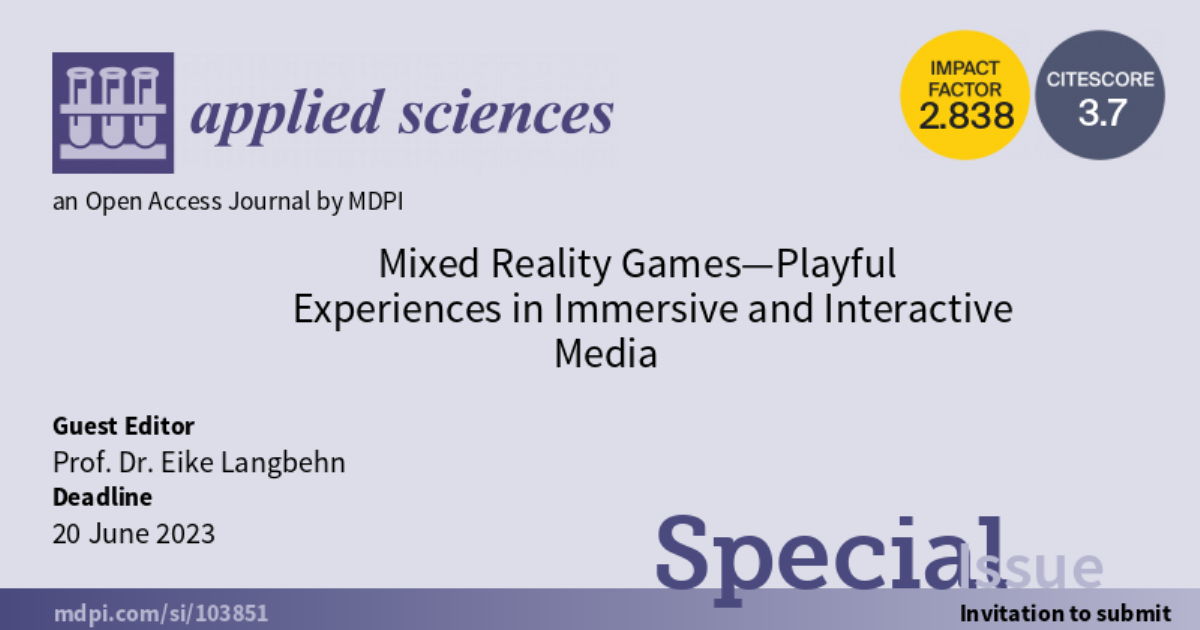Mixed Reality Games—Playful Experiences in Immersive and Interactive Media
A special issue of Applied Sciences (ISSN 2076-3417). This special issue belongs to the section "Computing and Artificial Intelligence".
Deadline for manuscript submissions: closed (20 June 2023) | Viewed by 25685

Special Issue Editor
Special Issue Information
Dear Colleagues,
Virtual, augmented and mixed reality (XR) technologies have received enormous attention in recent years. Nowadays, XR devices are used primarily in digital games and entertainment.
Games place particularly high demands on usability and accessibility. In most cases, games are consumed for entertainment and fun. This requires joyful user interfaces to keep up player motivation. Even more challenges for user interface design are added for XR games: Sense of presence, cyber sickness or spatial cognition. However, especially the spatiality of XR enables completely new kinds of interactions and game mechanics that can open up possibilities and innovations.
Additionally, beyond pure entertainment purposes, game mechanics can be exploited for serious applications such as health or training. The combination of XR and games has the potential to enhance involvement, understanding, performance or efficiency in these domains.
This Special Issue will publish high-quality research papers in the field of XR and games, spatial human–computer interaction, playful media, and 3D interface technologies. Of interest are papers that explore methods, techniques, technologies, reviews, (case) studies, applications, or novel ideas.
Prof. Dr. Eike Langbehn
Guest Editor
Manuscript Submission Information
Manuscripts should be submitted online at www.mdpi.com by registering and logging in to this website. Once you are registered, click here to go to the submission form. Manuscripts can be submitted until the deadline. All submissions that pass pre-check are peer-reviewed. Accepted papers will be published continuously in the journal (as soon as accepted) and will be listed together on the special issue website. Research articles, review articles as well as short communications are invited. For planned papers, a title and short abstract (about 100 words) can be sent to the Editorial Office for announcement on this website.
Submitted manuscripts should not have been published previously, nor be under consideration for publication elsewhere (except conference proceedings papers). All manuscripts are thoroughly refereed through a single-blind peer-review process. A guide for authors and other relevant information for submission of manuscripts is available on the Instructions for Authors page. Applied Sciences is an international peer-reviewed open access semimonthly journal published by MDPI.
Please visit the Instructions for Authors page before submitting a manuscript. The Article Processing Charge (APC) for publication in this open access journal is 2400 CHF (Swiss Francs). Submitted papers should be well formatted and use good English. Authors may use MDPI's English editing service prior to publication or during author revisions.
Keywords
- Game design and interaction design
- Human–computer interaction
- Virtual, augmented, and mixed reality
- Game mechanics and Gamification
- Playful media
- 3D user interfaces
- Spatial interaction
- 3D input and output
- Navigation and locomotion
- Immersion and presence
- VR sickness
- Perception, cognition, action
- Audio and haptic interfaces
- 3D rendering technologies
- Virtual humans
- Serious games
- Health games and Exergames
- News games
- Training and simulation





